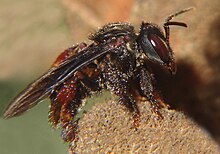| Nymphaea pulchella | |
|---|---|
| Scientific classification | |
| Kingdom: | Plantae |
| Clade: | Tracheophytes |
| Clade: | Angiosperms |
| Order: | Nymphaeales |
| Family: | Nymphaeaceae |
| Genus: | Nymphaea |
| Subgenus: | Nymphaea subg. Brachyceras |
| Species: | N. pulchella |
| Binomial name | |
| Nymphaea pulchella DC. | |
| Synonyms | |
| |
Nymphaea pulchella is a species of waterlily native to the regions spanning from Central and Southern Mexico to Brazil, as well as from the Bahamas to the Virgin Islands, including St. Croix.
Description
Vegetative characteristics
Nymphaea pulchella is an aquatic herb with cylindrical to subglobose tubers. The elliptic, suborbicular to orbicular leaves have a sinuate to dentate margin. The veins show minimal prominence on the abaxial leaf surface.
Generative characteristics
The diurnal flowers can extend up to 20 cm above the water surface. They are held up by glabrous, brownish, non-brittle peduncles with six primary central and 12-13 secondary peripheral air canals. The androecium consists of 43-80 stamens. The ellipsoid, smooth, hispid seeds have trichomes arranged in continuous longitudinal lines.
Reproduction
Vegetative reproduction
Proliferating pseudanthia are absent.
Generative reproduction
It is autogamous, but reproduction is more fruitful in the presence of pollinators. Flowering and fruiting occurs throughout the year. Generative reproduction is the main mode of reproduction.
Taxonomy
Publication
It was first described by Augustin Pyramus de Candolle in 1821.
Placement within Nymphaea
It is placed in Nymphaea subgenus Brachyceras.
Etymology
The specific epithet pulchella means "beautiful" or "pretty".
Conservation
In Puerto Rico, USA, it faces habitat destruction.
Ecology

Habitat
It occurs in freshwater habitats, such as lakes, ponds, lagoons, streams, and temporary puddles.
Pollination
The bee species Trigona spinipes is an effective pollinator of Nymphaea pulchella. In some cases, the bees coated in pollen fall into the stigmatic fluid and die. The flowers are also visited by the bee species Apis mellifera, as well as flies.
Herbivory
The bee species Trigona spinipes is florivorous, i.e. it consumes parts of the flowers of Nymphaea pulchella.
References
- ^ "Nymphaea pulchella DC". Plants of the World Online. Royal Botanic Gardens, Kew. Retrieved 19 July 2023.
- ^ Felix, C. D. M. P. (2019). "Etnobotânica, florística, e citogenética na Serra do Jatobá, no Cariri da Paraíba, nordeste do Brasil."
- ^ de Lima, C. T., Machado, I. C., & Giulietti, A. M. (2021). "Nymphaeaceae of Brasil." Sitientibus série Ciências Biológicas, 21.
- ^ Pellegrini, M. O. O. & Jardim Botânico do Rio de Janeiro. (n.d.-b). Nymphaea pulchella DC. Flora E Funga Do Brasil. Retrieved December 29, 2023, from https://floradobrasil.jbrj.gov.br/FB19912
- ^ "Regni vegetabilis systema naturale, sive ordines, genera et species plantarum secundum methodi naturalis normas digestarum et descriptarum." p. 51. (1821). Vereinigtes Königreich: (n.p.).
- ^ Chalegre, S. L., Domingos-Melo, A., de Lima, C. T., Giulietti, A. M., & Machado, I. C. (2020). Nymphaea pulchella (Nymphaeaceae) and Trigona spinipes (Apidae) interaction: From florivory to effective pollination in ponds surrounded by pasture. Aquatic Botany, 166, 103267.
- Marquina, S., Bonilla-Barbosa, J., & Alvarez, L. (2005). "Comparative phytochemical analysis of four Mexican Nymphaea species." Phytochemistry, 66(8), 921-927.
- Dictionary of Botanical Epithets. (n.d.). Retrieved December 29, 2023, from http://botanicalepithets.net/dictionary/dictionary.150.html
- What do those botanical names mean - Rainyside.com. (n.d.). Retrieved December 29, 2023, from https://www.rainyside.com/resources/reference/latin.html
- ^ Woodbury, R. O. (1975). "Rare and Endangered Plants of Puerto Rico: A Committee Report." p. 61. USA: U.S. Department of Agriculture, Soil Conservation Service.
- Liogier, A. H., Martorell, L. F. (2000). "Flora of Puerto Rico and adjacent islands : a systematic synopsis." p. 58. Puerto Rico: Ed. de la Universidad.
- Nymphaea
- Flora of the Bahamas
- Flora of Brazil
- Flora of Colombia
- Flora of Costa Rica
- Flora of Cuba
- Flora of the Dominican Republic
- Flora of Haiti
- Flora of the Leeward Islands
- Flora of Mexico
- Flora of Nicaragua
- Flora of Panama
- Flora of Puerto Rico
- Flora of Venezuela
- Flora of Southern America
- Plants described in 1821